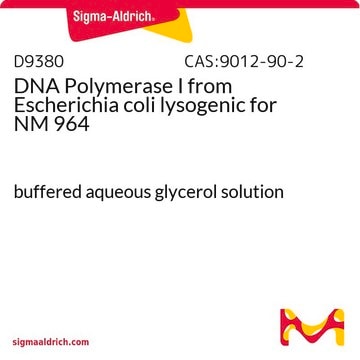D8276
DNA Polymerase I, Klenow Fragment from Escherichia coli
buffered aqueous glycerol solution
About This Item
Prodotti consigliati
Grado
for molecular biology
Forma fisica
buffered aqueous glycerol solution
PM
103 kDa
Concentrazione
~3,000 units/mL
N° accesso UniProt
Attività estranea
Endonuclease, none detected
Condizioni di spedizione
wet ice
Temperatura di conservazione
−20°C
Informazioni sul gene
Escherichia coli K12 ... polA(948356)
Categorie correlate
Descrizione generale
Applicazioni
- DNA sequencing by the Sanger dideoxy method
- Synthesis of the complementary strand of cDNA
- Filling in 5′-overhangs in double stranded DNA to form blunt ends
- Mutagenesis of DNA with second strand synthesis using oligonucleotides
- Labeling DNA by the random primer method
Componenti
Definizione di unità
Ricostituzione
Risultati analitici
Prodotti correlati
Avvertenze
Danger
Indicazioni di pericolo
Consigli di prudenza
Classi di pericolo
Resp. Sens. 1
Codice della classe di stoccaggio
10 - Combustible liquids
Classe di pericolosità dell'acqua (WGK)
WGK 1
Punto d’infiammabilità (°F)
Not applicable
Punto d’infiammabilità (°C)
Not applicable
Dispositivi di protezione individuale
Eyeshields, Gloves, multi-purpose combination respirator cartridge (US)
Certificati d'analisi (COA)
Cerca il Certificati d'analisi (COA) digitando il numero di lotto/batch corrispondente. I numeri di lotto o di batch sono stampati sull'etichetta dei prodotti dopo la parola ‘Lotto’ o ‘Batch’.
Possiedi già questo prodotto?
I documenti relativi ai prodotti acquistati recentemente sono disponibili nell’Archivio dei documenti.
I clienti hanno visto anche
Il team dei nostri ricercatori vanta grande esperienza in tutte le aree della ricerca quali Life Science, scienza dei materiali, sintesi chimica, cromatografia, discipline analitiche, ecc..
Contatta l'Assistenza Tecnica.









